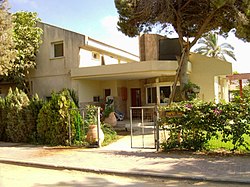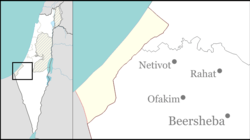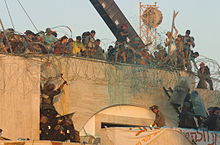| This article needs additional citations for verification. Please help improve this article by adding citations to reliable sources. Unsourced material may be challenged and removed. Find sources: "Kfar Darom" – news · newspapers · books · scholar · JSTOR (August 2014) (Learn how and when to remove this message) |
Place
| Kfar Darom כְּפַר דָּרוֹם | |
|---|---|
 | |
 | |
| Coordinates: 31°24′05″N 34°21′36″E / 31.40139°N 34.36000°E / 31.40139; 34.36000 | |
| Region | Gaza Strip |
| Affiliation | Religious Kibbutz Movement |
| Founded | 1930 (original) 1970 (re-establishment) |
| Founded by | Hapoel HaMizrachi members |
Kfar Darom (Hebrew: כְּפַר דָּרוֹם, lit. South Village) was a kibbutz and an Israeli settlement within the Gush Katif bloc in the Gaza Strip.
History
Kfar Darom was founded on 250 dunams of land (about 25 hectares or 60 acres) purchased in 1930 by Tuvia Miller for a fruit orchard on the site of an ancient Jewish settlement of the same name mentioned in the Talmud. Following the 1936–1939 Arab revolt in Palestine, Miller sold his land to the Jewish National Fund in 1946. A community was established on the land at the close of Yom Kippur on 5 and 6 October 1946, by Hapoel HaMizrachi's kibbutz movement as part of the 11 points in the Negev settlement plan.
In the summer of 1948, after numerous battles, the community was abandoned following a three-month siege by the Egyptian Army during the 1948 Arab–Israeli War.

Following Israel's victory in the Six-Day War in 1967, and its subsequent occupation of the Gaza Strip, a Nahal military outpost was established at the site in 1970. In 1989, this was converted to a civilian community by the Israeli national unity government of Shimon Peres (Alignment) and Yitzhak Shamir (Likud).
The village also had an elementary school, a kollel for religious (adult married men) students and the "Torah and Land" Institute, for research into religious laws relating to agriculture in Israel. The visitor center contained the Garden of Commandments Museum, which illustrated commandments relating to the Land of Israel.
The site of the former kibbutz is the Palestinian agricultural town Wadi as-Salqa.
Disengagement


At the point of the disengagement plan in 2005, there were about sixty families, totaling about 330 people, who earned their living from the free working professions, agriculture, and a central packing center for the vegetables produced by the Gaza settler communities.
References
- Fischbach, Michael R.: Jewish Property Claims against Arab Countries, New York 2008, p. 87
- Paying the Price for Peace Israeli Ministry of Foreign Affairs
- Kfar Darom Archived 16 December 2004 at the Wayback Machine Jewish Agency for Israel
| Jewish towns and villages depopulated during the 1947–1949 Palestine war | |
|---|---|
| Israel | |
| West Bank | |
| Gaza Strip | |
| Jordan | |
| See also | |
| Geopolitical areas defined based on the 1949 armistice lines | |
| Former Israeli settlements in the Gaza Strip (Hof Aza Regional Council) | |
|---|---|
| Gush Katif | |
| Other | |
- Former Israeli settlements in the Gaza Strip
- Former kibbutzim
- Nahal settlements
- Religious Israeli settlements
- Populated places established in 1946
- Populated places established in 1970
- Jewish villages depopulated during the 1948 Arab–Israeli War
- 1946 establishments in Mandatory Palestine
- 1948 disestablishments in All-Palestine (Gaza)
- 1970 establishments in the Israeli Military Governorate
- 2005 disestablishments in the Palestinian territories